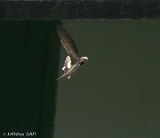
Little Swift
Encyclopedia

Bird
Birds are feathered, winged, bipedal, endothermic , egg-laying, vertebrate animals. Around 10,000 living species and 188 families makes them the most speciose class of tetrapod vertebrates. They inhabit ecosystems across the globe, from the Arctic to the Antarctic. Extant birds range in size from...
, superficially similar to a Barn Swallow
Barn Swallow
The Barn Swallow is the most widespread species of swallow in the world. It is a distinctive passerine bird with blue upperparts, a long, deeply forked tail and curved, pointed wings. It is found in Europe, Asia, Africa and the Americas...
or House Martin
House Martin
The Common House Martin , sometimes called the Northern House Martin or, particularly in Europe, just House Martin, is a migratory passerine bird of the swallow family which breeds in Europe, north Africa and temperate Asia; and winters in sub-Saharan Africa and tropical Asia...
. It is, however, completely unrelated to those passerine
Passerine
A passerine is a bird of the order Passeriformes, which includes more than half of all bird species. Sometimes known as perching birds or, less accurately, as songbirds, the passerines form one of the most diverse terrestrial vertebrate orders: with over 5,000 identified species, it has roughly...
species, since swift
Swift
The swifts are a family, Apodidae, of highly aerial birds. They are superficially similar to swallows, but are actually not closely related to passerine species at all; swifts are in the separate order Apodiformes, which they share with hummingbirds...
s are in the order Apodiformes. The resemblances between the groups are due to convergent evolution
Convergent evolution
Convergent evolution describes the acquisition of the same biological trait in unrelated lineages.The wing is a classic example of convergent evolution in action. Although their last common ancestor did not have wings, both birds and bats do, and are capable of powered flight. The wings are...
reflecting similar life styles. The former eastern race, House Swift
House Swift
The House Swift is a species of swift in the Apodidae family.It is found in Nepal, and Southeast Asia. It was formerly considered a subspecies of the Little Swift.-References:...
, is usually considered a separate species, Apus nipalensis.
These birds have very short legs which they use only for clinging to vertical surfaces. The scientific name comes from the Greek
Greek language
Greek is an independent branch of the Indo-European family of languages. Native to the southern Balkans, it has the longest documented history of any Indo-European language, spanning 34 centuries of written records. Its writing system has been the Greek alphabet for the majority of its history;...
απους, apous, meaning "without feet". They never settle voluntarily on the ground.
Little Swifts breed around habitation and cliffs from Africa
Africa
Africa is the world's second largest and second most populous continent, after Asia. At about 30.2 million km² including adjacent islands, it covers 6% of the Earth's total surface area and 20.4% of the total land area...
northeastwards through southern India
India
India , officially the Republic of India , is a country in South Asia. It is the seventh-largest country by geographical area, the second-most populous country with over 1.2 billion people, and the most populous democracy in the world...
and Sri Lanka
Sri Lanka
Sri Lanka, officially the Democratic Socialist Republic of Sri Lanka is a country off the southern coast of the Indian subcontinent. Known until 1972 as Ceylon , Sri Lanka is an island surrounded by the Indian Ocean, the Gulf of Mannar and the Palk Strait, and lies in the vicinity of India and the...
. Unlike the more northerly Common Swift
Common Swift
The Common Swift is a small bird, superficially similar to the Barn Swallow or House Martin. It is, however, completely unrelated to those passerine species, since swifts are in the separate order Apodiformes...
, many birds are resident, but some populations are migratory
Bird migration
Bird migration is the regular seasonal journey undertaken by many species of birds. Bird movements include those made in response to changes in food availability, habitat or weather. Sometimes, journeys are not termed "true migration" because they are irregular or in only one direction...
, and winter further south than their breeding areas. They wander widely on migration, and are seen as rare vagrants in much of Europe and Asia.
_at_nest_in_hyderabad,_ap_w2_img_0192.jpg)
Little Swifts spend most of their lives in the air, living on the insects they catch in their beaks. They drink on the wing, but roost on vertical cliffs or walls. They are notoriously slow risers in the mornings.
Little Swifts are readily identified by their small size. Their wingspan is 33 cm compared to the 42 cm of Common Swift. They are black except for a white rump, the white extending on to the flanks. They have a short square tail. The flight is fluttering like a House Martin.
The call is a high twittering.

